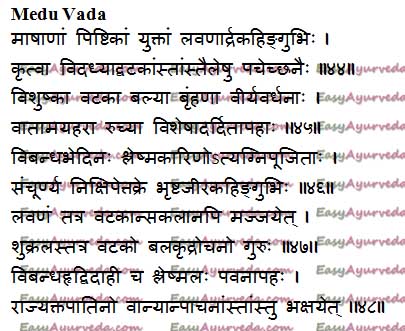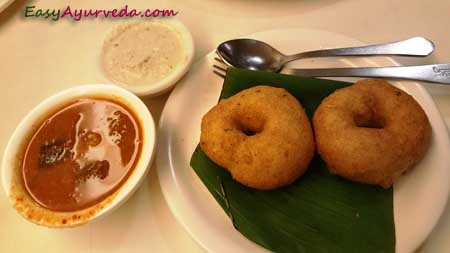Medu Vada: How to Make? Ayurveda Benefits
By Dr M S Krishnamurthy MD (Ayu)PhD.
Vada Idly, Vada Sambhar, Chutney, etc are the various combinations used in South India. Interestingly Medu Vada is in Ayurvedic practice since many centuries. This small write up is written to explore the classical view of food recipe – Vada.
Table of Contents
Classical reference

Classical reference: Bhavaprakasha – Kritanna varga/51 – 55.
Medu Vada
What is Medu Vada – dry and wet?
Black gram flour is taken and added to water (in which the rock salt, ginger and asafetida are added and dissolved) and fine dough is made. This is pressed a little and a bun plane is made or else a round mass is made with a whole at the center (present day – classical Vada) is made and cooked with suitable oil or ghee. When it becomes crispy it is taken out and served. This is called Dry Vada.

If this Vada is added to sour gruel or butter milk or curd it is called Wet Vada.
Qualities, benefits
Qualities of Vada:
It acts as
Vatahara – Balances Vata Dosha
Increases Kapha Dosha
heavy for digestion and
vidahi – may cause burning if not taken without suitable adjuvant.
Health benefits of Medu Vada:
Balya (energizer),
Brimhana (nutritive),
Veeryavardhaka (spermatogenic),
Ruchya (appetizer),
Malabhedaka (laxative),
Jatharagnishamaka (pacifier of excess digestive fire),
Shukrala (similar promoter/aphrodisiac) etc.
Read related: Papad – Ayurvedic Method Of Making, Health Benefits, Precautions
In general it is strengthening and growth promoting, increases virility and improves taste perception.
Application
The classical literatures emphasize to recommend this for Vata predominant conditions or in wasting disorders especially it is appreciated in facial paralysis as well as other paralytic disorders.
As it is nutritive and bulk enhancer it is good to gain weight. It promotes sperm and semen and hence it can be recommended in sexual debility, oligospermia etc. Due to laxative effect, in constipation and reduced fecal output it can be suggested.
Today ‘Dahi Vada’ is a very famous recipe in menu card. Where as classical texts have recommended to take Vada on soaking or mixing with fried cumin seeds, rock salt and asafoetida, along with curd or butter milk. Such a wet or soaked Vada increases the quantity of semen significantly.
Read related: Kheer – Payasam: Ayurvedic Method Of Making, Benefits, Side Effects
In classical literatures the word ‘Rajyakta’ is found and it is nothing but the ‘Raita’ used now a days. Vada soaked in sesame oil is undoubtedly a very good laxative.
Proper understanding and application of classical knowledge will help to derive the desired benefits out of the classical recipes. Vada is the typical example in this regard.
Click to consult Dr MS Krishnamurthy MD (Ayu), PhD
Note on vada as per Bhojana Kutuhalam
According to Bhojana Kutuhalam ninth chapter, vada which are dry increase the strength, nourishes the body and increases virility. checks diseases caused due to vitiated vata and imparts taste and especially cures facial paralysis . Dry vadas also treat constipation, aggravates kapha and stimulates digestive fire.
Vadas soaked in buttermilk added with powdered and fried asafetida, cumin seeds and salt increases semen, augment strength. It is heavy to digest, imparts taste, treats constipation, cause burning sensation, increases kapha and alleviates vata.








2 comments
Sanjay Pandey
Sir you mentioned… Vada soaked in Taita is undoubtedly a very good laxative. What is Taita ??
Dr J V Hebbar MD(Ayu)Author
Sorry. It is taila – sesame oil.